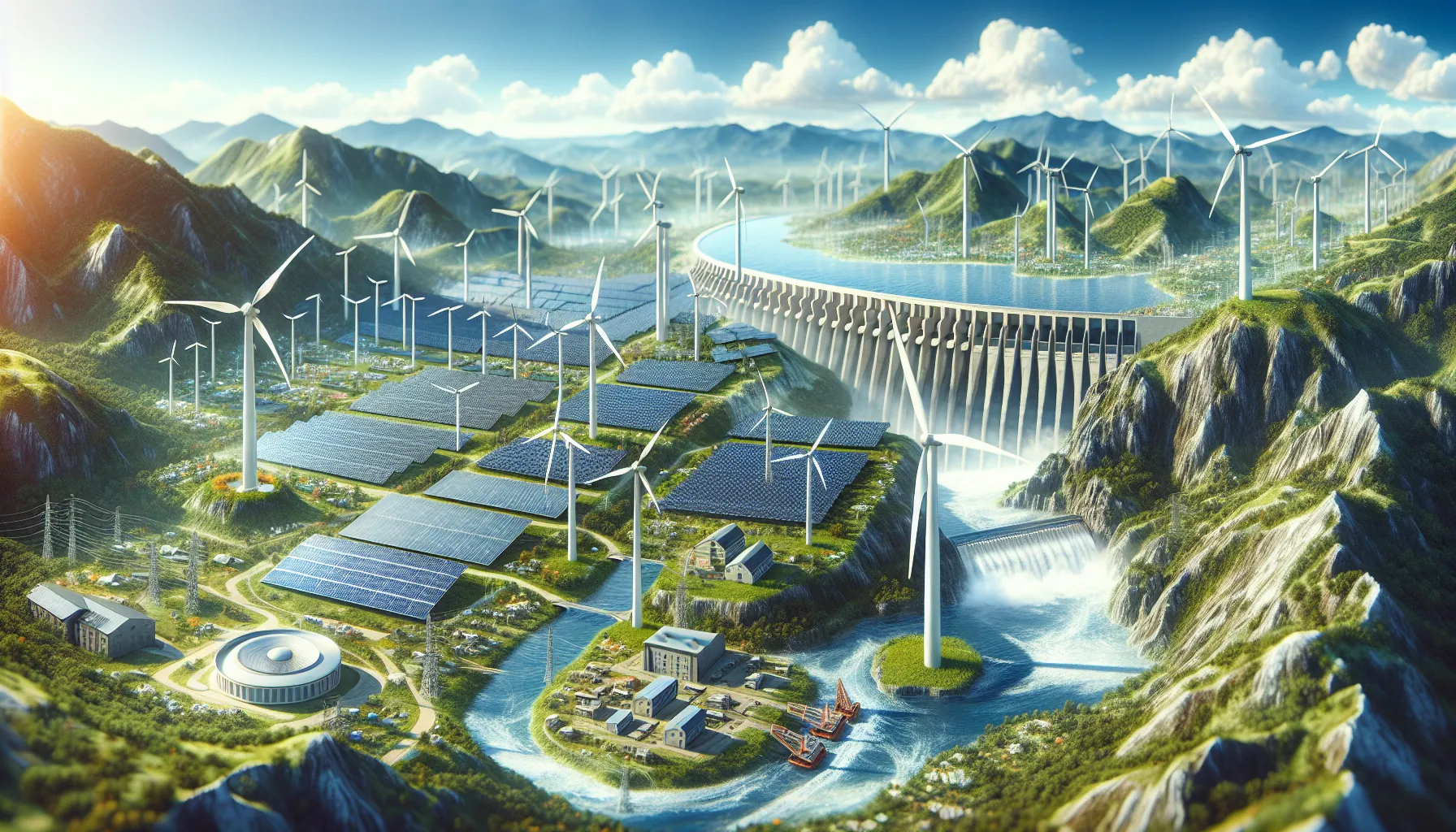As an experienced IELTS instructor, I’m excited to share a comprehensive IELTS Reading practice test focused on the impact of renewable energy on global investment portfolios. This topic is not only relevant for the IELTS exam but also crucial for understanding the evolving landscape of global investments in the face of climate change and sustainable development.
IELTS Reading Practice Test
Passage 1 (Easy Text)
The Rise of Renewable Energy Investments
In recent years, the global investment landscape has witnessed a significant shift towards renewable energy sources. This transformation is driven by growing concerns about climate change, technological advancements, and supportive government policies. As a result, renewable energy investments have become an increasingly important component of global investment portfolios.
Wind and solar power have emerged as the frontrunners in this green energy revolution. The cost-effectiveness of these technologies has improved dramatically, making them competitive with traditional fossil fuel-based energy sources. This has led to a surge in investments from both institutional and individual investors seeking to capitalize on the long-term potential of clean energy.
Moreover, the integration of renewable energy into existing power grids has become more efficient, addressing previous concerns about reliability and storage. Energy storage solutions, such as advanced batteries, have made significant progress, enabling a more stable and consistent supply of renewable energy.
Governments worldwide have implemented various incentives and regulations to promote renewable energy adoption. These include tax breaks, subsidies, and mandatory renewable energy targets for utilities. Such policies have created a favorable environment for investors, reducing risks and enhancing the attractiveness of renewable energy projects.
The impact of these investments extends beyond the energy sector. They contribute to job creation, technological innovation, and economic growth in many regions. Additionally, the shift towards renewable energy is reshaping global geopolitics, potentially reducing dependence on oil-producing nations and fostering energy independence for many countries.
However, challenges remain. The intermittent nature of some renewable sources, such as wind and solar, requires continued investment in energy storage and grid management technologies. Furthermore, the transition to renewable energy must be managed carefully to ensure energy security and minimize economic disruption in regions heavily dependent on fossil fuel industries.
Despite these challenges, the trend towards renewable energy investments shows no signs of slowing. As climate change concerns intensify and technology continues to advance, renewable energy is likely to play an increasingly central role in global investment strategies and energy policies.
Questions for Passage 1
1-5. Complete the sentences below.
Choose NO MORE THAN TWO WORDS from the passage for each answer.
- The shift towards renewable energy investments is partly driven by ___ and technological progress.
- Wind and solar power have become more ___ compared to traditional energy sources.
- Improvements in ___ have addressed concerns about the reliability of renewable energy.
- Governments have introduced ___ to encourage the adoption of renewable energy.
- The ___ of some renewable energy sources presents ongoing challenges for the industry.
6-10. Do the following statements agree with the information given in the passage?
Write:
TRUE if the statement agrees with the information
FALSE if the statement contradicts the information
NOT GIVEN if there is no information on this
- Renewable energy investments are only attractive to large institutional investors.
- The integration of renewable energy into existing power grids has become more efficient.
- All countries have the same policies regarding renewable energy adoption.
- The shift to renewable energy is creating new job opportunities.
- The transition to renewable energy will be completed within the next decade.
Passage 2 (Medium Text)
The Transformation of Global Investment Portfolios
The surge in renewable energy investments is fundamentally altering the composition of global investment portfolios. This shift is not merely a trend but a structural change in how investors approach risk, return, and long-term sustainability. The impact of renewable energy on investment strategies is multifaceted, affecting various asset classes and investment philosophies.
Traditionally, energy investments were dominated by oil, gas, and coal companies, which were seen as stable, high-yield options. However, the rise of renewable energy has disrupted this paradigm. Investors are increasingly reallocating capital from fossil fuel-based companies to renewable energy projects and clean technology firms. This reallocation is driven by both ethical considerations and financial prudence, as the long-term viability of fossil fuel investments comes under scrutiny.
The integration of Environmental, Social, and Governance (ESG) criteria into investment decision-making processes has further accelerated this shift. Many institutional investors, including pension funds and sovereign wealth funds, are now mandated to consider ESG factors, which often favor renewable energy investments. This has led to a significant increase in capital flows towards sustainable energy projects and companies.
The renewable energy sector offers a diverse range of investment opportunities. These include direct investments in renewable energy projects, such as wind farms or solar installations, as well as investments in companies developing clean energy technologies. Additionally, green bonds and other financial instruments specifically designed to fund environmental projects have gained popularity, providing investors with fixed-income options aligned with sustainability goals.
The impact of renewable energy on investment portfolios extends beyond the energy sector itself. It has implications for various industries, from automotive to construction, as these sectors adapt to a low-carbon economy. Investors are increasingly considering the carbon footprint and sustainability practices of companies across all sectors, influencing stock selection and portfolio construction.
However, the transition to renewable energy-focused portfolios is not without challenges. The sector can be volatile, with policy changes and technological advancements having significant impacts on investment performance. Moreover, as the sector matures, there are concerns about market saturation and potential bubbles in certain segments of the renewable energy market.
Despite these challenges, the long-term outlook for renewable energy investments remains positive. As global efforts to combat climate change intensify, and as renewable technologies continue to improve in efficiency and cost-effectiveness, their role in investment portfolios is likely to grow. This shift represents not just a change in energy sources, but a fundamental reorientation of global capital towards sustainable and responsible investment strategies.
Questions for Passage 2
11-15. Choose the correct letter, A, B, C, or D.
-
According to the passage, the shift towards renewable energy investments is:
A) A temporary trend
B) Limited to a few countries
C) A fundamental change in investment strategies
D) Only affecting small investors -
Traditional energy investments were considered:
A) High-risk, high-return options
B) Stable and high-yield
C) Environmentally friendly
D) Short-term investments -
The integration of ESG criteria has:
A) Slowed down investment in renewable energy
B) Only affected small companies
C) Led to increased capital flows to sustainable projects
D) Been rejected by most institutional investors -
Green bonds are described in the passage as:
A) High-risk investments
B) Only available to large corporations
C) Financial instruments for funding environmental projects
D) Less popular than traditional bonds -
The passage suggests that the impact of renewable energy on investment portfolios:
A) Is limited to the energy sector
B) Has no effect on other industries
C) Influences investment decisions across various sectors
D) Only affects developing countries
16-20. Complete the summary below.
Choose NO MORE THAN TWO WORDS from the passage for each answer.
The rise of renewable energy is transforming global investment portfolios. This change is driven by both ethical considerations and 16, as investors reassess the future of fossil fuel investments. The integration of 17 criteria has accelerated this shift, especially among institutional investors. The renewable energy sector offers diverse investment opportunities, including direct project investments and 18 for funding environmental initiatives. However, the sector faces challenges such as volatility and concerns about 19. Despite these issues, the long-term outlook remains positive, reflecting a 20___ of global capital towards sustainable investment strategies.
Passage 3 (Hard Text)
The Socioeconomic Implications of Renewable Energy’s Impact on Global Investment Portfolios
The paradigm shift towards renewable energy in global investment portfolios is not merely a financial phenomenon; it represents a profound socioeconomic transformation with far-reaching implications. This transition is reshaping industries, altering geopolitical dynamics, and redefining the concept of energy security on a global scale. The ripple effects of this shift extend beyond the realms of finance and energy, influencing social structures, labor markets, and international relations.
One of the most significant impacts of this transition is the redistribution of economic power. Historically, countries rich in fossil fuel resources held considerable economic and political leverage. However, the rise of renewable energy is democratizing energy production, allowing countries with abundant renewable resources – such as solar, wind, or hydroelectric potential – to emerge as new energy powerhouses. This shift is not only altering the global economic landscape but also reconfiguring international alliances and dependencies.
 Renewable Energy Sources
Renewable Energy Sources
The renewable energy sector has become a substantial source of employment, driving job creation in both developed and developing economies. However, this growth is not uniform across all regions. While new opportunities are emerging in renewable energy development, manufacturing, and services, traditional fossil fuel-dependent communities face significant challenges. The transition necessitates comprehensive strategies for workforce reskilling and economic diversification in affected regions to mitigate potential social and economic disruptions.
Investments in renewable energy are also catalyzing technological innovation across various sectors. The need for efficient energy storage solutions, smart grid technologies, and advanced materials for solar panels and wind turbines is spurring research and development. This innovation ecosystem is creating new industries and value chains, potentially reshaping the global competitive landscape. Countries and companies that lead in these technologies may gain significant economic advantages in the coming decades.
The shift towards renewable energy in investment portfolios is also influencing urban planning and infrastructure development. As investments flow into renewable projects, cities and regions are adapting their infrastructure to accommodate decentralized energy generation and distribution systems. This transformation is not only changing the physical landscape of communities but also altering the relationship between energy producers and consumers, with the rise of prosumers – individuals who both produce and consume energy.
Financial markets are evolving to accommodate this shift, with the emergence of new financial instruments and investment vehicles focused on renewable energy. The growth of green bonds, sustainability-linked loans, and specialized renewable energy funds is creating new opportunities for investors to align their portfolios with sustainability goals. This evolution is also putting pressure on traditional energy companies to adapt their business models or risk becoming stranded assets.
However, the transition is not without challenges. The intermittency of renewable energy sources poses technical challenges for grid stability and energy security. Addressing these issues requires significant investments in energy storage technologies and grid modernization. Additionally, the global nature of renewable energy supply chains raises concerns about new forms of resource dependencies, particularly regarding rare earth elements and other critical materials essential for renewable technologies.
The impact of renewable energy on global investment portfolios is also influencing international climate negotiations and policy-making. As private capital increasingly flows towards renewable projects, it is creating a positive feedback loop, encouraging governments to set more ambitious climate targets and implement supportive policies. This interplay between private investment and public policy is accelerating the global transition to a low-carbon economy.
In conclusion, the integration of renewable energy into global investment portfolios is a transformative force that extends far beyond financial markets. It is reshaping the global economic order, influencing social structures, and accelerating technological innovation. As this transition unfolds, it presents both opportunities and challenges, requiring careful management to ensure a just and sustainable energy future for all.
Questions for Passage 3
21-26. Complete the sentences below.
Choose NO MORE THAN THREE WORDS from the passage for each answer.
- The shift towards renewable energy is causing a ___ of economic power globally.
- Countries with abundant renewable resources are emerging as new ___.
- The renewable energy sector is contributing significantly to ___ in many economies.
- The transition to renewable energy requires strategies for ___ in affected regions.
- Investments in renewable energy are driving innovation in ___ and other technologies.
- The rise of ___ is changing the relationship between energy producers and consumers.
27-33. Do the following statements agree with the information given in the passage?
Write:
TRUE if the statement agrees with the information
FALSE if the statement contradicts the information
NOT GIVEN if there is no information on this
- The transition to renewable energy is uniformly beneficial for all regions and communities.
- Renewable energy investments are influencing urban planning and infrastructure development.
- Traditional energy companies are at risk of becoming stranded assets if they don’t adapt.
- The intermittency of renewable energy sources has been completely solved.
- The growth of renewable energy is creating new forms of resource dependencies.
- Private investment in renewable energy is encouraging governments to set more ambitious climate targets.
- The transition to renewable energy will be completed within the next decade.
34-40. Complete the summary below.
Choose NO MORE THAN TWO WORDS from the passage for each answer.
The impact of renewable energy on global investment portfolios is causing a significant socioeconomic transformation. This shift is altering 34 dynamics and redefining energy security. It’s leading to a redistribution of economic power, with countries rich in 35 emerging as new energy leaders. The transition is creating jobs but also requires 36 in affected communities. Renewable energy investments are driving 37 across various sectors and influencing 38. New financial instruments like 39 are emerging to support this transition. However, challenges remain, including the 40___ of some renewable energy sources and potential new resource dependencies.
Answer Key
Passage 1
- climate change
- cost-effective
- energy storage
- incentives and regulations
- intermittent nature
- FALSE
- TRUE
- NOT GIVEN
- TRUE
- NOT GIVEN
Passage 2
- C
- B
- C
- C
- C
- financial prudence
- ESG
- green bonds
- market saturation
- reorientation
Passage 3
- redistribution
- energy powerhouses
- job creation
- workforce reskilling
- energy storage
- prosumers
- FALSE
- TRUE
- TRUE
- FALSE
- TRUE
- TRUE
- NOT GIVEN
- geopolitical
- renewable resources
- workforce reskilling
- technological innovation
- urban planning
- green bonds
- intermittency
This IELTS Reading practice test on the impact of renewable energy on global investment portfolios covers a range of topics from basic concepts to complex socioeconomic implications. It’s designed to test various reading skills including skimming, scanning, and detailed comprehension. Remember to manage your time effectively during the actual test, allocating about 20 minutes for each passage. Practice regularly with diverse topics to improve your reading speed and comprehension.
For more insights on related topics, you might find these articles helpful:
- Impact of Renewable Energy on Fossil Fuels
- Clean Energy Investment Trends
- Renewable Energy Policies in 2024
Keep practicing and stay informed about global issues to enhance your IELTS Reading performance!


